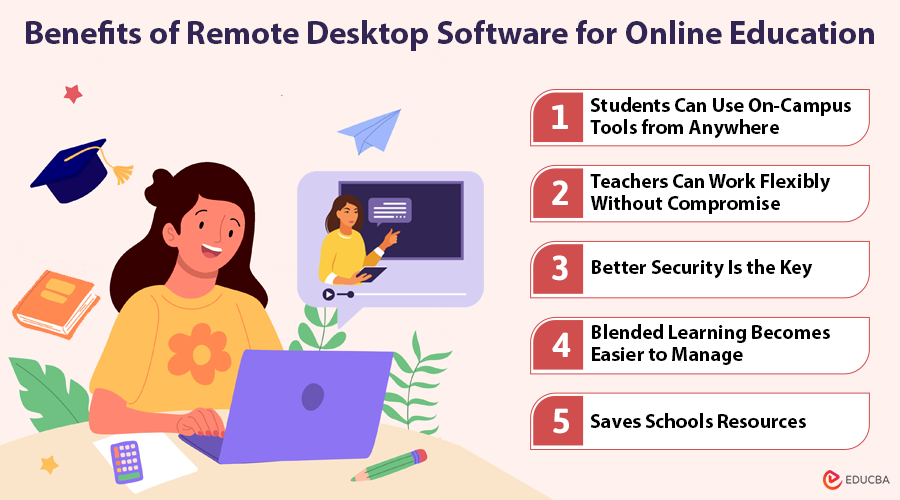
Remote Desktop Software for Online Education: Overview
Online education has gone from being an alternative to becoming a necessity. What started as a temporary shift during global lockdowns in 2020 has now evolved into a lasting model for flexibility, accessibility, and growth. According to a World Economic Forum report, over 65% of students expect their learning experience to remain virtual.
However, for digital learning to be effective long-term, the technology behind it has to be seamless. That is where remote desktop software steps in.
Simply put, nowadays, schools are not just looking for virtual classrooms. They are looking for ways to replicate the full learning experience from anywhere. That might include access to campus devices, licensed software, and IT support. Remote desktop tech is quickly becoming the infrastructure that makes this possible.
Amazing, right? With that in mind, let us explore why educational institutions that adopt remote desktop software for online education early are gaining a clear advantage.
What is Remote Desktop Software?
Before going further, you should have a basic understanding of the software. Remote desktop software lets users securely access and control another computer from a different location as if they were sitting right in front of it.
In an educational setting, it enables students, teachers, and IT teams to connect to school systems from anywhere. The best remote access software for schools offers seamless performance, real-time support, and advanced security features. This makes it easy to manage devices and access campus-based tools without needing to be physically on-site.
With the best remote desktop software for online education, schools can offer secure, smooth, and consistent access to resources, no matter where users are.
Top 5 Benefits of Remote Desktop Software for Online Education
Following are the benefits of remote desktop software for online education:
#1. Students Can Use On-Campus Tools from Anywhere
Not every student owns a high-end laptop. Many essential learning apps, especially those related to science, design, or coding, require more computing power than the average home device can offer.
With remote desktop software for online education, students can:
- Log in to on-campus computers from home
- Use licensed school software
- Save their work on the school network
This simple shift helps bridge the digital divide, one of the biggest concerns in modern education.
#2. Teachers Can Work Flexibly Without Compromise
Teaching does not stop when the bell rings. Teachers spend hours preparing lessons, grading work, and updating student records. Remote desktop software gives them secure access to school systems from anywhere.
They can:
- Access the same environment they use at school.
- Use shared drives or grading platforms.
- Continue lesson planning from home.
Moreover, it is not just about flexibility. For schools with hybrid or rotating schedules, this kind of access supports consistent efforts from teachers — even when they are not physically present.
#3. Better Security Is the Key
According to some sources, cyberattacks increased by 38% in 2022. And when it comes to schools, they are not just protecting lesson plans. Instead, they’re guarding student data, staff records, and private financial information.
Remote desktop software for online education helps protect this data through:
- End-to-end encryption,
- Two-factor authentication and
- Session logs.
#4. Blended Learning Becomes Easier to Manage
Blended learning is no longer a buzzword—it is becoming the default. Many schools now offer part-time schedules, digital assignments, and off-site collaboration.
Remote desktop software supports this model by:
- Letting students access the same system at school and home,
- Helping teachers upload and manage lessons from anywhere,
- Making it easier to run virtual labs or group projects.
All in all, modern technology helps schools stay flexible while keeping the experience consistent.
Stat Check: A 2022 survey showed that 7 in 10 high schools planned to keep blended learning in some form, even post-pandemic.
#5. Saves Schools Resources
Tech budgets in education are tight. Every investment has to do more than one job. Here is how remote desktop software for online education helps save resources:
- Reducing hardware needs (students can use older devices),
- Limiting on-site IT calls,
- Cutting costs on extra software licenses.
Final Thoughts
The digital classroom is not just about video calls and assignments. It is about giving everyone — teachers, students, and others in between — access to the same quality of resources, no matter where they are.
Remote desktop software for online education is powering that shift. Helping students log into campus labs from home or letting teachers work late without carrying files on USB sticks is changing how education works.
Lastly, the future of learning is flexible. With good tech, that future just gets a lot more manageable.
Recommended Articles
We hope this article helped you understand how remote desktop software for online education is shaping the future of learning. Check out these recommended articles for more insights on educational technology, digital learning tools, and virtual classroom strategies.

